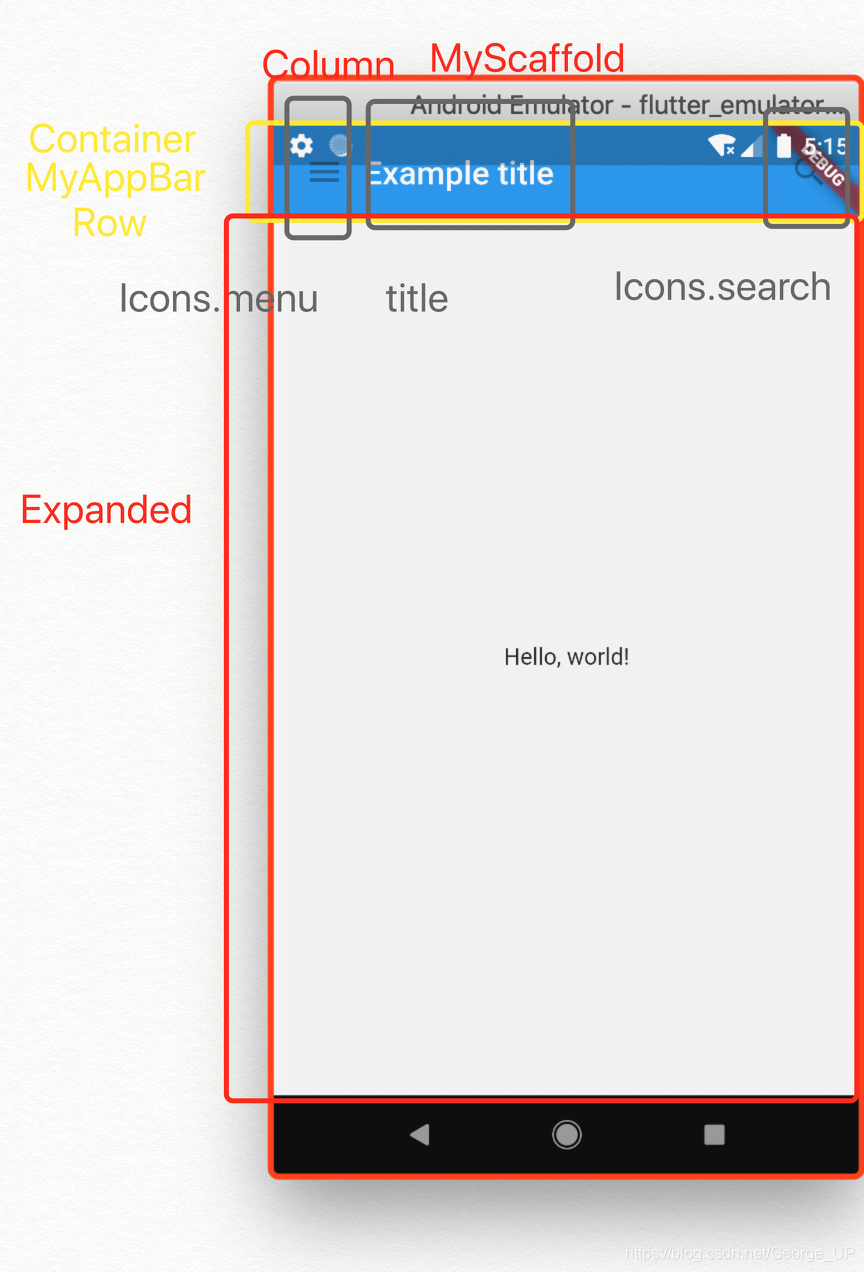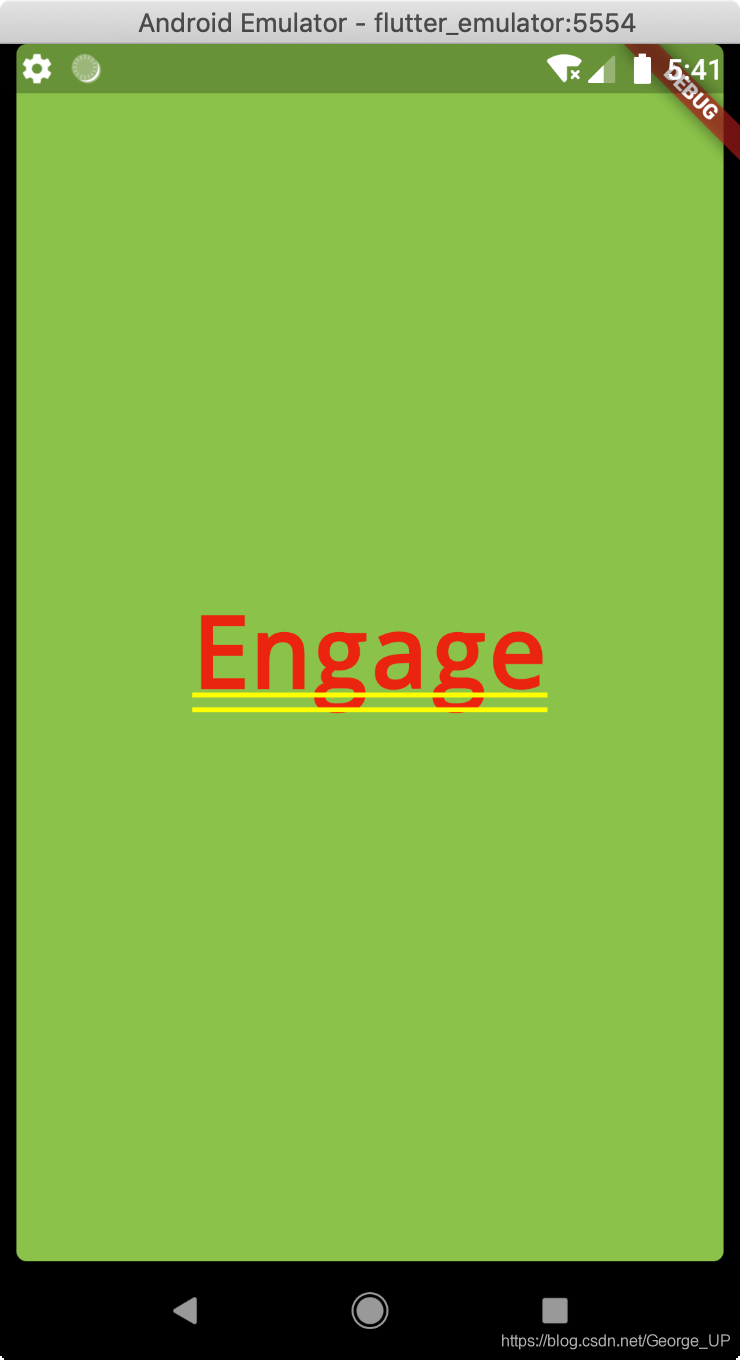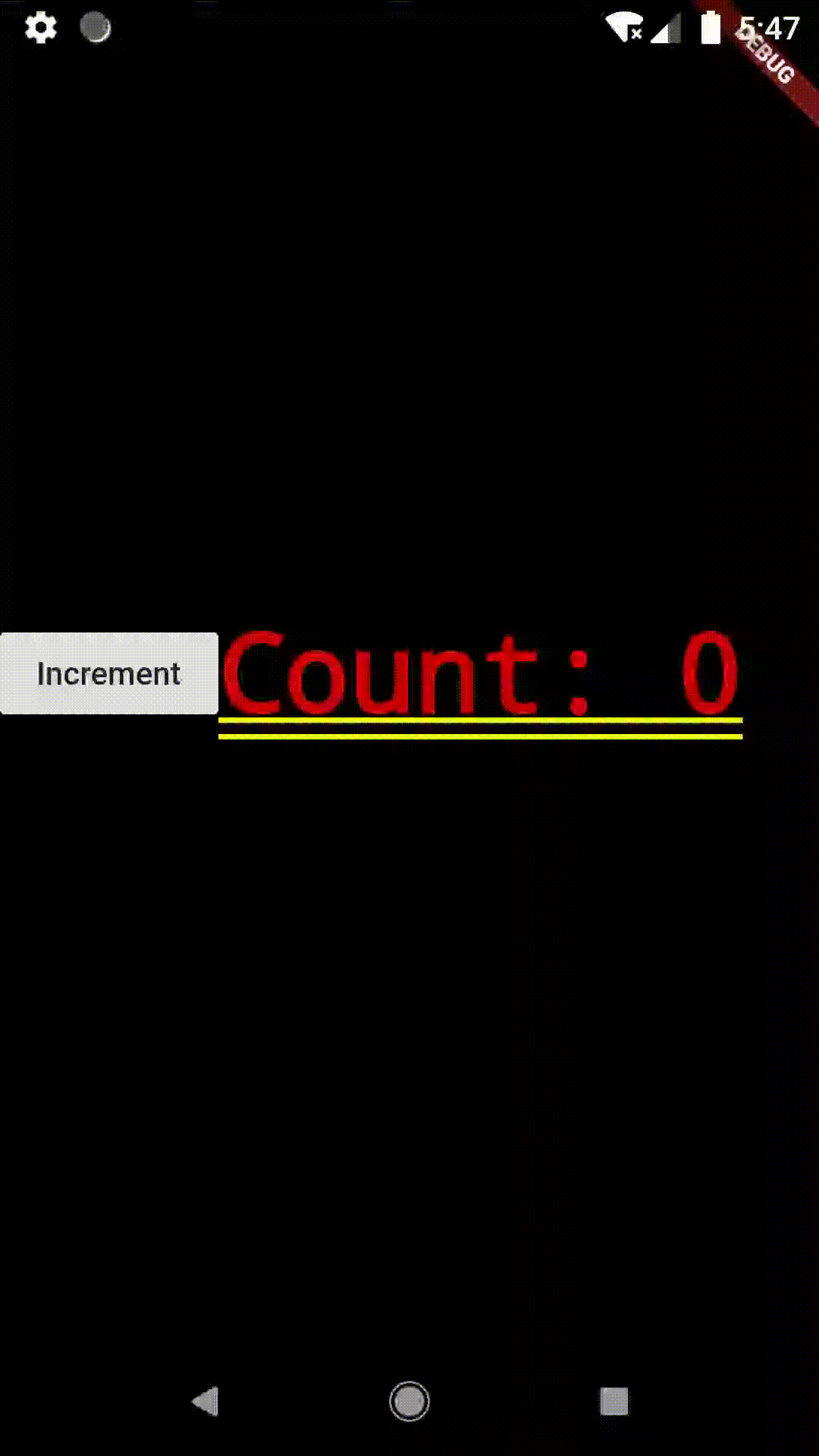文章目录
所有内容均学习自 Flutter中文网
最简单的一种(仅有一个Widget)
关系图
代码例:
import 'package:flutter/material.dart';
void main() {
runApp(
new Center(
child: new Text(
'Hello, world!',
textDirection: TextDirection.ltr,
),
),
);
}
效果

不简单的很多种
关系图
Widget 的常用布局(个人觉得理解为控件也行)
PS:Widget子类中的字段往往回定义为final
- Text:带格式的文本
- Row:使Widget在水平方向上布局
- Column:使Widget在垂直方向上布局
- Stack:取代线性布局 (类似LinearLayout),允许子 widget 堆叠, 可以使用 Positioned 来定位他们相对于Stack的上下左右四条边的位置。
- Container:矩形视觉元素。container 可以装饰为一个BoxDecoration, 如 background、一个边框、或者一个阴影。 Container 也可以具有边距(margins)、填充(padding)和应用于其大小的约束(constraints)。另外, Container可以使用矩阵在三维空间中对其进行变换。
- Expanded:填充尚未被其他子项占用的的剩余可用空间,可以拥有多个children, 然后使用flex参数来确定他们占用剩余空间的比例。
代码例子
import 'package:flutter/material.dart';
class MyAppBar extends StatelessWidget {
MyAppBar({this.title});
// Widget子类中的字段往往都会定义为"final"
final Widget title;
@override
Widget build(BuildContext context) {
return new Container(
height: 56.0, // 单位是逻辑上的像素(并非真实的像素,类似于浏览器中的像素)
padding: const EdgeInsets.symmetric(horizontal: 8.0),
decoration: new BoxDecoration(color: Colors.blue[500]),
// Row 是水平方向的线性布局(linear layout)
child: new Row(
//列表项的类型是 <Widget>
children: <Widget>[
new IconButton(
icon: new Icon(Icons.menu),
tooltip: 'Navigation menu',
onPressed: null, // null 会禁用 button
),
// Expanded expands its child to fill the available space.
new Expanded(
child: title,
),
new IconButton(
icon: new Icon(Icons.search),
tooltip: 'Search',
onPressed: null,
),
],
),
);
}
}
class MyScaffold extends StatelessWidget {
@override
Widget build(BuildContext context) {
// Material 是UI呈现的“一张纸”
return new Material(
// Column is 垂直方向的线性布局.
child: new Column(
children: <Widget>[
new MyAppBar(
title: new Text(
'Example title',
style: Theme.of(context).primaryTextTheme.title,
),
),
new Expanded(
child: new Center(
child: new Text('Hello, world!'),
),
),
],
),
);
}
}
void main() {
runApp(new MaterialApp(
title: 'My app', // used by the OS task switcher
home: new MyScaffold(),
));
}
效果

使用Material组件
Material应用程序以MaterialApp widget开始,该widget在应用程序的根部创建了一些有用的widget,其中包括一个Navigator, 它管理由字符串标识的Widget栈(即页面路由栈)。Navigator可以让您的应用程序在页面之间的平滑的过渡。 是否使用MaterialApp完全是可选的,但是使用它是一个很好的做法。
PS:换句话说就是Material里面有很多好用的类似框架一样的组件可以直接调用
代码例
import 'package:flutter/material.dart';
void main() {
runApp(new MaterialApp(
title: 'Flutter Tutorial',
home: new TutorialHome(),
));
}
class TutorialHome extends StatelessWidget {
@override
Widget build(BuildContext context) {
//Scaffold是Material中主要的布局组件.
return new Scaffold(
appBar: new AppBar(
leading: new IconButton(
icon: new Icon(Icons.menu),
tooltip: 'Navigation menu',
onPressed: null,
),
title: new Text('Example title'),
actions: <Widget>[
new IconButton(
icon: new Icon(Icons.search),
tooltip: 'Search',
onPressed: null,
),
],
),
//body占屏幕的大部分
body: new Center(
child: new Text('Hello, world!'),
),
floatingActionButton: new FloatingActionButton(
tooltip: 'Add', // used by assistive technologies
child: new Icon(Icons.add),
onPressed: null,
),
);
}
}
效果

这种方法是用Material中的Scaffold代替了上一例中的Container,此外多了一个floatingActionButton
处理手势
代码例
import 'package:flutter/material.dart';
void main() {
runApp(new MaterialApp(
title: 'Flutter Tutorial',
home: new MyButton(),
));
}
class MyButton extends StatelessWidget {
@override
Widget build(BuildContext context) {
return new GestureDetector(
onTap: () {
print('MyButton was tapped!');
},
child: new Container(
height: 36.0,
padding: const EdgeInsets.all(8.0),
margin: const EdgeInsets.symmetric(horizontal: 8.0),
decoration: new BoxDecoration(
borderRadius: new BorderRadius.circular(5.0),
color: Colors.lightGreen[500],
),
child: new Center(
child: new Text('Engage'),
),
),
);
}
}
效果

该GestureDetector widget并不具有显示效果,而是检测由用户做出的手势。 当用户点击Container时, GestureDetector会调用它的onTap回调, 在回调中,将消息打印到控制台。您可以使用GestureDetector来检测各种输入手势,包括点击、拖动和缩放。
许多widget都会使用一个GestureDetector为其他widget提供可选的回调。 例如,IconButton、 RaisedButton、 和FloatingActionButton ,它们都有一个onPressed回调,它会在用户点击该widget时被触发。

根据用户输入改变widget
之前的例子都是无状态widget从它们的父widget接收参数, 它们被存储在final型的成员变量中。 当一个widget被要求构建时,它使用这些存储的值作为参数来构建widget。
为了构建更复杂的体验 - 例如,以更有趣的方式对用户输入做出反应 - 应用程序通常会携带一些状态。 Flutter使用StatefulWidgets来满足这种需求。StatefulWidgets是特殊的widget,它知道如何生成State对象,然后用它来保持状态。
代码例
1⃣️
import 'package:flutter/material.dart';
void main() {
runApp(new MaterialApp(
title: 'Flutter Tutorial',
home: new Counter(),
));
}
class Counter extends StatefulWidget {
// This class is the configuration for the state. It holds the
// values (in this nothing) provided by the parent and used by the build
// method of the State. Fields in a Widget subclass are always marked "final".
@override
_CounterState createState() => new _CounterState();
}
class _CounterState extends State<Counter> {
int _counter = 0;
void _increment() {
setState(() {
// This call to setState tells the Flutter framework that
// something has changed in this State, which causes it to rerun
// the build method below so that the display can reflect the
// updated values. If we changed _counter without calling
// setState(), then the build method would not be called again,
// and so nothing would appear to happen.
_counter++;
});
}
@override
Widget build(BuildContext context) {
// This method is rerun every time setState is called, for instance
// as done by the _increment method above.
// The Flutter framework has been optimized to make rerunning
// build methods fast, so that you can just rebuild anything that
// needs updating rather than having to individually change
// instances of widgets.
return new Row(
children: <Widget>[
new RaisedButton(
onPressed: _increment,
child: new Text('Increment'),
),
new Text('Count: $_counter'),
],
);
}
}
2⃣️
import 'package:flutter/material.dart';
void main() {
runApp(new MaterialApp(
title: 'Flutter Tutorial',
home: new Counter(),
));
}
class CounterDisplay extends StatelessWidget {
CounterDisplay({this.count});
final int count;
@override
Widget build(BuildContext context) {
return new Text('Count: $count');
}
}
class CounterIncrementor extends StatelessWidget {
CounterIncrementor({this.onPressed});
final VoidCallback onPressed;
@override
Widget build(BuildContext context) {
return new RaisedButton(
onPressed: onPressed,
child: new Text('Increment'),
);
}
}
class Counter extends StatefulWidget {
@override
_CounterState createState() => new _CounterState();
}
class _CounterState extends State<Counter> {
int _counter = 0;
void _increment() {
setState(() {
++_counter;
});
}
@override
Widget build(BuildContext context) {
return new Row(children: <Widget>[
new CounterIncrementor(onPressed: _increment),
new CounterDisplay(count: _counter),
]);
}
}
效果(两种方式,相同效果)

方式1⃣️是点击button与_counter自增放在同一个Widget中完成
方式2⃣️是分开两个Widget完成
响应widget生命周期事件
在StatefulWidget调用createState之后,框架将新的状态对象插入树中,然后调用状态对象的initState。子类化State可以重写initState,以完成仅需要执行一次的工作。 例如,您可以重写initState以配置动画或订阅platform services。initState的实现中需要调用super.initState。
当一个状态对象不再需要时,框架调用状态对象的dispose。 您可以覆盖该dispose方法来执行清理工作。例如,您可以覆盖dispose取消定时器或取消订阅platform services。 dispose典型的实现是直接调用super.dispose。
PS:B是A的子Widget
Key
您可以使用key来控制框架将在widget重建时与哪些其他widget匹配。默认情况下,框架根据它们的runtimeType和它们的显示顺序来匹配。 使用key时,框架要求两个widget具有相同的key和runtimeType。
Key在构建相同类型widget的多个实例时很有用。例如,ShoppingList构建足够的ShoppingListItem实例以填充其可见区域:
如果没有key,当前构建中的第一个条目将始终与前一个构建中的第一个条目同步,即使在语义上,列表中的第一个条目如果滚动出屏幕,那么它将不会再在窗口中可见。
通过给列表中的每个条目分配为“语义” key,无限列表可以更高效,因为框架将同步条目与匹配的语义key并因此具有相似(或相同)的可视外观。 此外,语义上同步条目意味着在有状态子widget中,保留的状态将附加到相同的语义条目上,而不是附加到相同数字位置上的条目。
全局Key
您可以使用全局key来唯一标识子widget。全局key在整个widget层次结构中必须是全局唯一的,这与局部key不同,后者只需要在同级中唯一。由于它们是全局唯一的,因此可以使用全局key来检索与widget关联的状态。






















 742
742

 被折叠的 条评论
为什么被折叠?
被折叠的 条评论
为什么被折叠?








